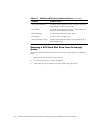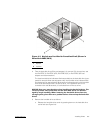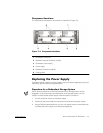
7-4 Dell PowerVault 200S, 201S, 210S, and 211S Storage Systems Installation and Service Guide
In the event of a drive failure, systems with these host adapter cards display the fol-
lowing SCSI hard-disk drive indicator lights located at the top of each SCSI hard-disk
drive carrier (see "Indicators" in Chapter 1):
If a drive shows signs of imminent failure, the drive online indicator turns
on and the drive fault indicator blinks on briefly each second.
If a drive fails, the drive online indicator turns off and the drive fault indica-
tor blinks off briefly each second.
For all SCSI hard-disk drive light indicator scenarios, including the faults described
above, see Table 6-1 in Chapter 6, "Installing Drives."
7URXEOHVKRRWLQJWKH6\VWHP
When the storage system power is turned on, the system performs a power-on
self-test (POST), which checks all the components. During POST, all of the indicators
for each SCSI hard-disk drive blink briefly, all of the enclosure indicators light, and the
enclosure buzzer beeps briefly. When the POST is completed, the indicators are
lighted based on the descriptions in "Indicators," in Chapter 1.
To troubleshoot the storage system, perform the following steps:
1. Is one of the following three events occurring?
All the installed hard-disk drive status indicators and the enclosure status
indicators remain lit after system start-up for more than 10 seconds.
The enclosure status indicators stay lit while the installed hard-disk drive sta-
tus indicators blink.
Only the enclosure status fault indicator stays lit while all other indicators are
off.
Yes. On a nonredundant storage system, the enclosure module could be defec-
tive. Replace the module.
On a redundant storage system, one of the enclosure modules could be defec-
tive. Perform the following steps:
a. Turn off the power.
b. Loosen the screw at the top of module B (see Figure 7-4) and pull it halfway
out of the module bay.
c. Turn on the power.
If the indicator light-emitting diodes (LED) go out after the POST, module B
could be defective. If the LEDs stay on, module A could be defective.
d. Try replacing the enclosure module that is suspected of being defective.
No. Go to step 2.


















